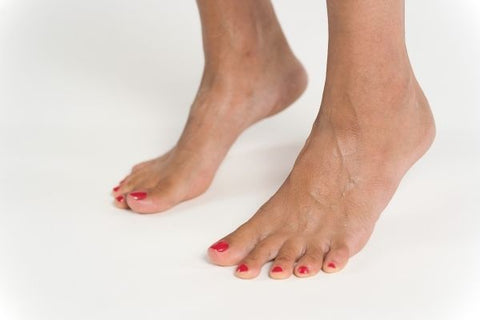Barefoot running: Humans have been running for two million years – only recently have we started spoiling ourselves with shoes
“Humans have been running for at least two million years – and of course, for most of that time, humans were running barefoot. Modern running shoes were actually only invented in the mid-1970s," says Professor Daniel Lieberman. He started researching how people run – and even started running barefoot himself. Barefoot running has incredible benefits for the human body.
It benefits your feet, joints, and your entire body. Plus, it can even improve your mood.
Your shoes are blindfolding your feet
Running shoe manufacturers claim that you need a strong and soft outsole for running. That’s not true.
During natural running, the soles of the feet never stop exploring the ground beneath them. They tell the brain, "Look out, pothole! Brace your muscles!" They act like your body’s built-in sensors – and a thick outsole on a shoe is like a blindfold that blocks these sensors from functioning correctly. Your brain has no idea what’s underneath your feet and worse: Even if the brain sends instructions, your feet can’t use them to respond to the terrain.
What happens?
- The brain doesn’t receive enough information to maintain balance.
- It can’t properly evaluate which muscles to activate.
- The result is a high risk of injury.
With a strong outsole, you’re essentially running blind. Sure, you’re already used to running with your feet blindfolded, but try taking off your shoes sometime. You’ll feel pure joy – like someone has uncovered your eyes.

There’s strength in your toes
Try this simple exercise:
- Stand up straight on the floor.
- Focus on the way your toes dig into the ground.
- Now, use your toes to lift your whole body up to stand on your tiptoes. Make sure that this movement comes from your toes. Your calf muscles should only be used to help your toes lift you.
See? Your toes can lift the entire weight of your body – that’s how strong they are. Unfortunately, you can’t use their strength when you wear regular running shoes.

Your toes have a tremendous amount of strength. When given the space, they can lift your entire body.
Classic shoes have a completely different shape than our feet, which fails to provide enough space for our toes. That’s why we often just throw our feet forward instead of using our toes to push off the ground.
It’s only when you start running barefoot or running in real barefoot shoes that you realize what your body is capable of doing.
Reading tip: Barefoot and performance: Take your shoes off and discover your full potential
It’s like someone hitting you in the heel with a hammer
Do you know what Professor Lieberman discovered when he studied runners who run in shoes and those who run barefoot? There are big differences in the way that they run.
"The shoe has a big heel that’s designed to make it very comfortable to land on your heel, so shod runners land on the heel and then bring their foot down. So, when you land on your heel, your body comes to a dead stop. There’s an impact that’s like somebody hitting on the heel with a hammer about two to three times your body weight," he explains in a video.
We’ve become used to striking with our heel wearing shoes, but this causes a huge force of impact, which even the strongest outsole can’t absorb.

We land on our heels when we run in regular running shoes.
Barefoot runners run differently. They strike on the front part of the foot, which acts as a perfect cushioning mechanism without overloading your foot or body. Once you learn to run barefoot, your joints will thank you.
Will barefoot running cause injuries?
You’ve probably heard that “a foot needs a solid shoe”, but this isn’t true. Sturdy shoes actually deactivate the muscles of your feet, so your foot can’t react in time to an unexpected pothole or gravel on the running path. Ironically, the risk of injury is higher when you wear solid running shoes.
"Good toe support also means a well-supported ankle, which is not possible to achieve when your toes are cramped in a shoe,” says renowned physiotherapist Clara Lewitová.
Please note: An elastic sock can also constrict the toes. Therefore, when switching to barefoot shoes, be sure to change socks as well. Read more in our article: Walking barefoot in socks.

Your ankle doesn’t need the protection of a solid shoe. In barefoot shoes, the muscles of your feet can protect it.
Run for the joy of it
Lightness, freedom, and joy. That’s what we experience when we run in a healthy way. If it’s hard to breathe and you have the feeling that you left your lungs at home, something is wrong.
Switch slowly over to barefoot walking, and you’ll start to see a difference. Your body straightens up – and suddenly, you’ll find that it’s easier to breathe.
And when we say, "Run for the joy of it," we mean it. Barefoot running stimulates your brain, which acts as a great meditation technique that can actually make you happier.
Good news: You don’t have to run completely barefoot
You might not love the idea of running on a hot cycle path or a muddy dirt track with just your bare feet. Fortunately, well-designed barefoot shoes that deliver the same experience as running in your bare feet already exist.
But beware! Not all barefoot shoes are created equal. If you truly want to run healthy, your barefoot shoes should:
- Have thin soles
- Provide plenty of toe space
- Be lightweight
- Allow flexibility in all directions

Real barefoot shoes are flexible, lightweight, and roomy.
“Barefoot” shoes often only come with a thin sole, but forget about toe space, which is equally important for the health of your feet and your entire body.
Here at Ahinsa shoes, we have a big advantage: Our shoes were specially designed by physiotherapists. As a result, we’ve considered all the most important parameters. In addition, we made sure to develop running shoes that breathe and last for years. Have you seen them?
We don’t know of any other shoes that benefit your feet the way Ahinsa shoes do. If you come across any that manage to outshine Ahinsa shoes in all the essential specifications, let us know. We’ll give you 50% off a new pair of shoes.
Barefoot is a joy, but start slow
We’ve been walking around in shoes for so long that our feet have become weak and sensitive. That’s why you can’t just take your shoes off and go barefoot right away.
Luckily, you can easily learn barefoot running. Start with walking first and feel every step. Use the natural bounce of your toes and avoid striking with your heel. In future articles, we’ll show you how to do it.
But that doesn’t mean you have to wait to free your feet. You can start now. We’ve thought about those of you who don’t have much experience with barefoot walking and running and developed shoes that make the transition easier. The Ahinsa shoes Comfort line come with double cushioning that absorbs impacts while also providing you with the benefits of a barefoot stride.
As soon as you're ready to make the switch, simply remove the insole to get barefoot shoes. These simple tips from physiotherapists can also help.

Run healthy, be happy in Ahinsa shoes.
Do you dare to do something good for your health? Experience the freedom of running on your own feet.











